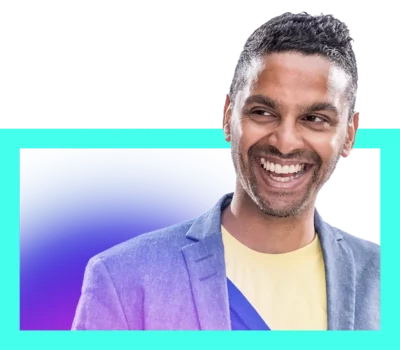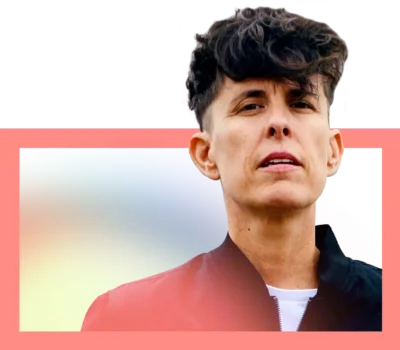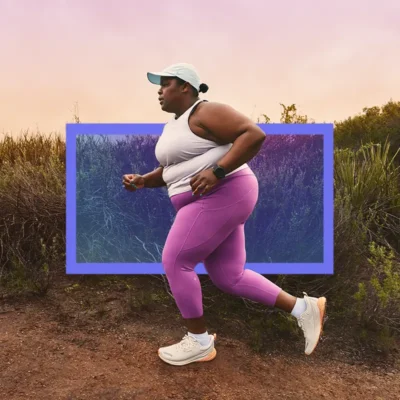Let your body be the guide
What do you do when your own body feels like the enemy? Spoken word artist and activist Andrea Gibson (You Better Be Lightning) spends years struggling with chronic illness, feeling as if their body is at odds with their anxious mind. It’s only when they learn to surrender control and embrace their physical sensations that they allow their body to guide them back to joy.
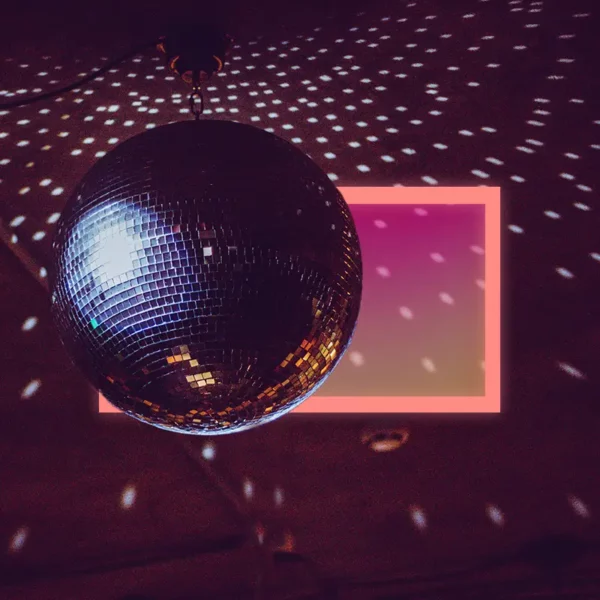
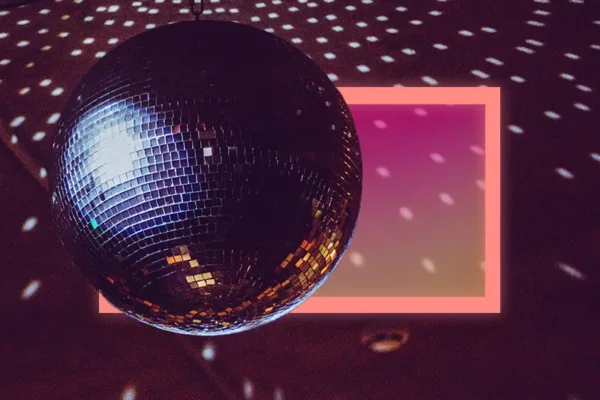
Table of Contents:
Transcript:
Let your body be the guide
ANDREA GIBSON: A remix of “Believe” by Cher comes on. The dance floor erupts. Do you believe in life after love? Some shout yes! Some shout no! I lose myself in the music. I start circling my arms, air traffic control style. It’s one of my weird signature moves I’m notorious for. It always makes my friends laugh. I just love it so much.
ROHAN GUNATILLAKE: Spoken word artist and activist Andrea Gibson has an unexpected passion for basketball. Flying across the court and finessing hard jump shots, they feel their anxieties melt away. But when Andrea is diagnosed with a chronic disease, their body slowly becomes their enemy. In this week’s Meditative Story, Andrea shares how in good times and bad, we can let our body guide us back to joy.
Today’s episode also deals with cancer diagnosis and treatment, so please take care if these are sensitive subjects.
In this series, we combine immersive first-person stories, breathtaking music, and mindfulness prompts so that we may see our lives reflected back to us in other people’s stories. And that can lead to improvements in our own inner lives.
From WaitWhat, this is Meditative Story. I’m Rohan, and I’ll be your guide.
The body relaxed. The body breathing. Your senses open. Your mind open. Meeting the world.
GIBSON: I step out of my front door into the freezing cold air. It’s got to be at least 10 below. Banks of snow line the street, pushed aside by the snowplows. They’re as tall as mountains. It’s quiet and already getting dark. I walk down the driveway in my winter boots — carefully, so I don’t slip. I’m wearing my black and teal snowsuit and the mittens my grandmother made me. They’re still a little too big, but I’m growing into them.
I make my way down the street to the park. The ground is slick with ice. Snowflakes sparkle in the air and drift to the ground, filling the empty lot where the carnival comes in the summer. I’m 11 years old, in my little hometown of Calais, in the northeast of Maine. I drag a shovel behind me, my basketball tucked under my arm.
At the park, the softball field is on my right, blanketed with white frost. There’s no one here but me. I step onto the court and start shoveling. I gradually unearth the white lines so I can practice my foul shots. I do my best to shake off the cold.
It’s already getting dark. Fortunately, the street lights around the court flicker on. There are only about 4,000 people in my town. But we’re a basketball town. I’ve been obsessed with this game since the third grade. I’m not a natural. So, I practice a lot. Once the court is cleared of snow, I start dribbling. The ball hits the cement over and over. It’s like a heartbeat. I dribble faster and faster until it’s no longer a ball. It’s a blur.
Now, I’m running, up and down the court, back and forth. I throw off my mittens. I want to feel this. I pass the ball from one hand to the other, press my fingers into the bumps on the surface of the rubber. It’s like reading braille. I leap into the air, fading back into a perfect jump shot I’ve practiced a thousand times.
There’s no better sound than the swoosh of the ball through the net.
I’ve always been sporty. My mom says my first word was ‘ball.’ She also thinks I invented the fast break, where you race ahead of everyone on either team and score. It’s this feeling of being chased, but it’s the opposite of fear. It’s excitement. It’s thrilling.
I know a lot about fear. Off the court, I am scared all of the time about everything. At night, I check the windows for burglars or invaders of any kind. I’m afraid my dad will crash his car and we’ll die. I’m afraid to stand by the lake, because I worry there might be a tsunami. When a friend of mine gets a nut allergy, I think I must have a nut allergy. And I’m afraid of getting bullied or beat up by other kids for being different. For looking like a boy. For dressing like a boy. For being a closeted queer kid in the 80’s in rural Maine.
Even birthday parties make me nervous. I want to be around my friends, but the balloons. They terrify me. I’m always afraid they’re going to pop, like a firework. When I’m seven years old, I see a mylar balloon floating in the kitchen at a friend’s house. My fear changes my body. It goes cold. My chest tightens. I stop being able to feel anything — my face, my hands, or my feet. I feel this tiny me, deep down inside, frantically trying to escape. I don’t want any of the other kids to know. When no one is looking, I slowly open a window and push the shiny balloon outside. It drifts up into the cloudy sky, and I take a breath. Like the balloon, there’s a lightness to me, but it’s not a good lightness. I’m desperate to be grounded — to be in my body, but I’m not.
When I play basketball, my body is totally here — solid, fluid, right now. My mind goes quiet. All the fear is gone. I’m no longer in my head. My muscles know all the rules, all the moves. It feels so good. I imagine I’m guarding Magic Johnson. And he can’t get past me. I steal the ball and leap towards the hoop.
The part of the court under the net is called the paint. I love that. Everywhere else, that fear that I might get sick or hurt permeates every moment, every movement. But this feels like a creative canvas. Here, my body does what it’s trained to do, what it wants to do. I jump and I twist and I soar and I am absolutely free. I wish I could feel this all the time.
GUNATILLAKE: The body can serve as a haven for our awareness. Let’s enjoy that now, like Andrea is in this moment, becoming aware of any feelings of solidity or fluidity that are here.
GIBSON: A giant disco ball rotates on the ceiling, scattering diamonds of light across the darkened room. Across a sea of sweat-drenched bodies. Moving, reaching, jumping to the music. There is so much beauty here. I’m in love with everyone in this room.
It’s 2001 in Denver, near the town I moved to in my early 20’s. Tracks is one of a handful of queer clubs where my friends and I come to dance. It’s an amazing space with this huge dance floor as soon as you walk in. But also smaller side rooms with different music, more dancing. And a balcony that overlooks it all.
I watch the spotlight scan the crowd. It stops on different people, giving them the floor. They love it. They open up. Like they’re bursting out of a cocoon.
A remix of “Believe” by Cher comes on. The dance floor erupts. Do you believe in life after love? Some shout yes! Some shout no! I lose myself in the music. I start circling my arms, air traffic control style. It’s one of my weird signature moves I’m notorious for. Then I slap my own ass. It always makes my friends laugh. People are pointing like, that’s not how people dance! But I don’t care. I just love it so much.
The front windows of the club are blacked out, like so many of the queer clubs in Denver. This is a space where all of us can feel safe. Here, I have permission to dress and be sexy in my way. Tonight, I wear a men’s shirt with pearl buttons, jeans, and these ugly big brown shoes my friends call the clown shoes. I’m only five-foot-five. They have an inch-and-a-half platform. I feel tall.
I wish nights like this could last forever, but they don’t. Within a year, I start to feel sick. Chronic migraines, vertigo, sinus problems, nausea, diminished cognition, neuropathy, intense mood swings, panic attacks, muscle cramping. I’m tired. My body aches. As the years go on, the pain gets more severe. I stop going to clubs.
Some nights, I wake up screaming, sweating. The sheets tangled around my body. It takes so much effort to release my limbs. I wake my partner, because I can’t limp to the bathroom without someone to lean on. The only thing worse than the pain is the anxiety of knowing I may never get better. This isn’t some imagined illness from my childhood. In 2009, I’m diagnosed with chronic Lyme Disease.
My doctor tells me the bacterium causes inflammation in my brain. That’s why now, I have panic attacks even more intense than anything I experience as a kid. Knowing this both helps, and doesn’t. I stare up at the ceiling. Sink back into myself.
I try antibiotics. A new diet. I learn that I can no longer do repetitive movements. I used to be able to run, but now I can’t. I start to live with a new set of rules to care for my ailing body: don’t carry this bag, don’t walk too far, don’t look in the mirror. I won’t like what I see.
I’ve been performing my poetry in front of live audiences since moving to Colorado. It’s how I make my living. But after I start treatment, I can barely make it through an hour-long set. I buy a child’s pink sequin dance suit at a shop near a venue and start wearing it under my butch-looking outfits. It’s so small, it squeezes all my muscles, almost like a compression bandage. It helps me get through my shows.
My body — the body that once leapt through the paint, that tore through fast breaks and landed championship jump shots, now, this body stands between me and my freedom.
But for some reason, when I’m able to dance, at home, in the green room, on the side of the road during long car trips, my body works. There’s no repetition. A new move every second. It’s almost like I become a puppet to the music. I stop trying to control everything. There are no rules, no practiced choreography. My body does what it wants to do. It feels out of control, but in the very best way. It’s like giving it up in the way that people give it up to God. I give it up to the music.
This is the only time I forget the pain just for a few moments. My body allows me to be who I am — sexy and funny, without shame or fear. I never breathe so hard as when I’m dancing or playing basketball. But this, this is the opposite of a panic attack.
It’s like my body is trying to tell me to just follow its lead even off the dance floor. But I don’t know how. I get frustrated. How am I supposed to trust my body when it’s hurting me? The flare ups always come back. And so does the anxiety. Treatment is slow going — ups and downs. My body feels terrible most of the time. And there are long stretches where I just don’t want to dance. I don’t want to do much of anything. It’s overwhelming. Every thought is telling me: My body is an enemy that I am too weak to fight.
It’s spring in Colorado. Everything is blooming. There are bunnies, squirrels. It’s so green. But I just can’t make myself go outside. It’s like life is happening and I’m just lying here on an ugly gray couch. I can’t stand it. I freaking hate this couch. And I am parked on it.
My partner Meg and I moved into this house together, and for a while, things were better. After 15 years of chronic illness, the Lyme disease still flares, but I can usually find temporary relief, or I could. Now the pandemic has closed the bars. I can’t go dancing, even if I wanted to. My spirit is as deflated as the dusty basketball in my garage. All of my shows have been canceled.
I’m very quarantined. And after a panic attack I had while alone at home one day, I’m now terrified of being alone. I’m afraid to even go on a walk by myself. What if something happens? I’m filled with that familiar feeling of my body being my worst enemy. The fear that anything and everything could hurt me.
I wake up with a new pain in my stomach. I’ve never felt anything quite like it before. I do tests, and more tests. And then…I get the news I’ve been afraid of my whole life: I have cancer. Ovarian. I’m 45 years old.
Chemotherapy is gonna suck. But I decide to do it anyway. Meg and I have a call with my natural oncologist. I seek out holistic approaches to ease my treatment. They ask if I’ve been exercising.
“Yeah,” I say. “I’m athletic. I’ve been doing Crossfit.”
Meg just looks at me with her mouth wide open.
“You have not been doing Crossfit!” she whispers loudly, and I realize I have no idea what Crossfit is, if it’s not the 7 or 8 minutes of casual movement I do each day.
The doctor tells me that I need to be lifting weights. She says it helps people tolerate chemo. Like even on the days I have chemo, I should lift weights. What? Is she crazy? This seems bonkers. I can’t imagine having the strength to work out right now, let alone after a round of chemo. But the idea of making chemo more tolerable, of healing my body, I am thrilled by that idea.
GUNATILLAKE: Andrea is being asked to do something difficult here: to push their already weakened body. Are there things you do to take care of your body, even when you don’t feel like it? Where do you sense that strength and healing coming from, when you need it most?
GIBSON: When the time comes, my friends know what to do. They come over and surround me in bed. After today’s chemo, I feel terrible. Like I’ve been struck by lightning while drinking cyanide. But my friends are standing there, holding blue dumbbells and smiling at me. They almost pick me up out of the bed, so I can sit.
“Just do three curls!,” says my friend Bethy. “I can’t do it,” I say. She wraps my fingers around the weights and stares at me.
Finally, I relent. With all my effort, I slowly pull the 10-pound weight up into a bicep curl. My chest feels so tight. One of the side effects of my chemo is it makes me feel like an elephant is sitting on my chest. I manage a few curls and collapse back onto the bed. My friends clap. It’s so ridiculous. I would laugh if I felt like I had the breath. After a short break, we do it all again.
Ten minutes later, just ten minutes. I can’t believe the difference. I feel a million times better. It’s the weirdest thing. It actually works.
I slowly start to move again. Meg and I convert the garage into a gym. I’m hiking, playing basketball. I’ve got cancer, I’m getting chemotherapy, and I feel strong? And then it gets weirder, because instead of thinking my body is the enemy, I start to fall in love with my body. I’m so grateful. I’m grateful for my friends. I’m grateful to be alive.
Loosening up my fear, I’m able to stop blaming my body. I want to feed it with strength and health. Let it become my teacher. My guide. I flex my muscles for my friends and it’s so goofy, and we all end up laughing. It’s about, yeah, I have muscles, but mostly, I’m alive.
When I struggled with Lyme disease, I thought of the pain as just pain. I thought of suffering as suffering and I couldn’t conceive of there being something larger than myself, or any purpose for that pain. I was mad at it. I let it consume everything. But now, with cancer, I’m committed to looking at this through a different lens. I could never imagine that an illness could heal my spirit in many ways. Inexplicably, I feel overwhelmed with gratitude — adored by the universe that gifted me this body of mine.
I had stopped listening to myself. I had stopped listening to this body that wants to move, that wants to be strong. I stopped listening to that me that exists on the dance floor and under the basketball hoop. Until cancer, I hadn’t loved myself well enough to really follow my body’s lead outside of those moments. But I’m no longer trapped in my controlling mind. I’m finding my way out. The worst has already happened. So instead of feeling anxiety, I’m finding…joy. I’m surrendering to the beauty of the natural rhythms of life and I’m finally surrendering to my body.
At home, the light outside the window turns from afternoon to evening. Pink clouds hang in the western sky above the Rocky Mountains. We got rid of the ugly couch and replaced it with an emerald one, the color of the sea. A giant neon sign on the wall above it says, “Stay Tender.” Tonight, it’s glowing.
It’s been two years since my cancer diagnosis. And today is the day Meg and I both knew might come, but hoped wouldn’t. It’s the day we find out the cancer has recurred. My doctor says it’s incurable.
After a long, deep breath, I think: Well, they can’t do anything for me anymore. Okay. More surrender.
Now, my life is mine. It’s a new kind of freedom.
Meg and I have a quiet dinner. We don’t quite know what to do with ourselves. What happens now? Where do we go next?
Suddenly, I stand up. I’m restless. I start shifting my weight from side to side. My body wants to move. It wants to dance. So, I listen. My body, my sick body, is not something to be controlled. It’s my guide.
Meg turns on the stereo. It’s upbeat. It might seem incongruent with the mood, but for some reason it works. And I dance. Meg starts dancing with me. We blast Beyonce. We dance and we dance for what seems like hours. We take turns giving each other the spotlight. We’re dripping with sweat. I’m waving my arms, doing all my moves, even the worm. We’re laughing. We’re crying.
There is no pain. There is no grief. How is this possible? I think. How is it possible we have so much joy right now?
In this moment, my body is saying, “I’m here and I’m here and everything is okay tonight, right here.” I could exist in the future where I’m dying, but nothing in this moment feels like I’m dying. I’m so alive. The moment is alive. It’s how I feel playing basketball, which I do, every day now, in our driveway. My body is teaching me to cherish it. To be enchanted by life. This moment is gorgeous and it’s always right here. For all of us.
There are always going to be times when the pain of living feels overwhelming. When you’re exhausted. When the fear and anxiety take over your brain and separate you from feeling in your body, from the aliveness of your spirit. But our bodies want to be heard. They are fighting for us, with us. Showing us the path back to strength. To growth. To joy. To living every moment we are here.
I want to tell everybody: Joy is right here.
Rohan’s closing meditation
GUNATILLAKE: Andrea. Thank you so much.
You know, the thing that I can’t stop thinking about from Andrea’s story is the dancing. They speak about it so evocatively. It’s where their body works. It knows what to do, even if what it does is the wildest of moves. And of course, dance felt the only natural thing to do in that most challenging of moments.
So, how about we dance? Or more precisely, let’s do a short closing meditation together, inspired by how Andrea describes what it is for them to dance. And what better way to do that, than by using Andrea’s words themselves. But first let’s drop into the body.
However your day has been, whatever mental momentum you might have, allowing it to be here, but rather than getting caught up in it, instead, dropping your attention into the body.
Letting the belly be soft.
Letting the body be comfortable. Life is hard enough. We don’t need our body to be in any particular configuration or posture to do meditation. However it is now, is just right.
Breathing how you are breathing, right now.
Sensing into the body as a whole.
Now, to Andrea’s words…
“On the dance floor, my body works. There’s no repetition. A new move every second.”
There is an organic-ness, a healthy chaos, to how Andrea describes dancing.
What if our body was a dance, a dance of sensations and feelings and experiences?
So resting with the sense of the body as a whole, let it be a container for the dance.
And notice what sensations arise within it.
Our mind, our attention, free to roam throughout the whole body, watching the sensations here like a show — the loud sensations and the quieter ones.
“It’s almost like I become a puppet to the music. I stop trying to control everything.”
Whether in meditation or in life, there can be such a tendency towards control. We want things to be in a certain way, so we force things or we ignore the bits that fall outside of our plan.
But the more we get into mindfulness, the more we realize that what the contents of our mind, our experience, is less important to the quality of our attention. So let’s be a puppet. Let go of the wheel, but still know where the mind is taken to. Know what comes up.
“There are no rules, no practiced choreography. My body does what it wants to do. It feels out of control in the very best way. It’s like giving it up in the way that people give it up to God. I give it up to the music.”
Letting go or surrendering is hard. And the best way to get better at doing it, is to notice where we are still tangled up. So as we close this meditation, let’s again restate our intention to allow whatever happens in our body to just happen — to let the dance of sensations do its thing. To let those sensations guide us where they want to go.
So thank you, Andrea, again, for your wonderful story.
And thank you. I wish you a wonderful week ahead.
We’d love to hear your personal reflections from Andrea’s episode. How did you relate to their story? You can find us on all your social media platforms through our handle @MeditativeStory. Or you can email us at: [email protected]
